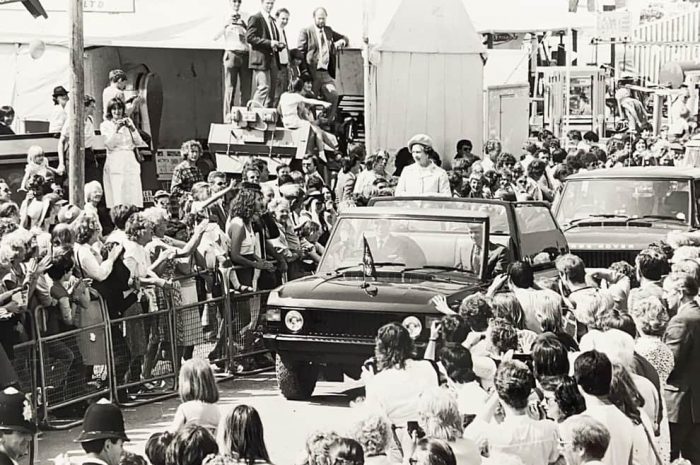Goodbye Queen Elizabeth II, arise King Charles III

By John Broven
It was like a “JFK” or “9/11” remember-where-you-were moment when the news broke Thursday, just after 1:30 p.m. EST: “Queen Elizabeth II has died.” For this Brit expat, it was a big shock even though she was 96 years old. Only two days before, she had held the “kissing the hands” ceremony with new prime minister, Liz Truss (C).

It became clear the queen’s loss was being felt far beyond the United Kingdom as tributes poured in from every corner of the globe, signaling the enormous impact of a 70-year reign during which she performed her often centuries-old duties with wisdom, dignity, gentle good humor and an essential mystique.
The new King Charles III, her son aged 73, caught the moment when he said in a statement, “I know her loss will be deeply felt throughout the country, the Realms and the Commonwealth, and by countless people around the world.”
I am a member of the knighted Mick Jagger-Elton John-Paul McCartney generation (where did I go wrong?). It was Jagger who summarized our thoughts when he tweeted, “For my whole life Her Majesty, Queen Elizabeth II, has always been there.” And now she isn’t. The second Elizabethan era is over.
The queen’s death Sept. 8 in Balmoral, Scotland, has been covered extensively by the media. Briefly, she was born in Mayfair, London, on April 21, 1926; married Philip, Duke of Edinburgh — her pillar of strength — on Nov. 20, 1947; became queen of the U.K. and other Commonwealth realms on Feb. 6, 1952, also head of the Church of England; was a working mother with four children including Charles; and owned a string of corgi dogs and racehorses through the years.
Such basic facts obscure the sweeping social and economic changes she saw in her reign, without revolution or revolt, from postwar austerity and the Swingin’ ’60s through to post-modern Britain, even as the sun set on the old British Empire. Soon the currency notes, coins and postage stamps bearing her likeness will be phased out and replaced.
Personal reflections? My first big memory was in relation to the death of Elizabeth’s father, King George VI, in 1952 while she was on a trip to Kenya, East Africa. I was in Mrs. Vidler’s class at Polegate Primary School, East Sussex, and you could hear the proverbial pin drop when we were told “the king is dead.” A dark February Wednesday morning became even darker. In our childhood grief, we had no idea nor cared that the queen’s first prime minister was Winston Churchill. She was only 25 when ascending the throne.
The coronation did not take place until June 2, 1953, but what a glorious affair it was with celebrations in every city, town and village. Some 20 million viewers were able to watch the glittering, expensive ceremony from Westminster Abbey live on television, with many households — including ours — buying their first TVs, in black and white.
As Jagger indicated, the queen was a constant, whether for the annual Christmas televised message that highlighted her strong Christian faith, the State Opening of Parliament, Trooping the Colour, the Royal Ascot and Epsom Derby horserace meetings, or various other occasions.
I saw her in person twice, both during my management spells at Midland Bank, Haywards Heath, West Sussex, in the 1970s and ‘80s. The first occasion was when she visited the neighboring headquarters of the Royal Commonwealth Society for the Blind. Imagine my surprise when I was walking to my car after work and, with nobody else around, she passed by me in the royal vehicle with no motorcade or security guards in sight. I swear she gave a little regal wave. The next time was when she presented prizes at the South of England Show in Ardingly, where the bank’s meet-and-greet pavilion gave us a ringside view. There was a majestic aura that seeped from her as she beguiled everybody at the agricultural showground — as she did elsewhere in a long lifetime of public service.
King Charles III
What of King Charles III, who represents continuity and has made a promising start to his reign. An often unfairly misunderstood man, he has been ahead of his time on environmental matters, wildlife preservation and climate change. His views on architecture were more controversial if personal. On a different level, his image was severely dented by the disastrous marriage to Diana, with whom he had William — now heir to the throne as Prince of Wales — and current-U.S. resident Harry. Charles married longtime flame Camilla Parker Bowles in 2005 and she is now queen consort. Time has gradually healed the British public’s disdain toward them both.
It is not widely appreciated that Charles founded the Prince’s Trust. For a while I was a trust business counselor in Ashford, Kent, and can attest to the value of the scheme for young entrepreneurs. Another factoid is that he has been patron of The Goon Show Preservation Society. The website noted, in the spirit of the groundbreaking 1950s comedy show, that “we would like to thank Prince Charles for agreeing to be our patron and look forward to the coming years with trembling socks.”
Britain now has a novice king and a novice prime minister, both unelected by the people at large. There are difficult days ahead for a country badly hit by the coronavirus pandemic, the self-induced Brexit debacle, inflation currently running at 10% with soaring energy costs due to the Russia-Ukraine war, rumblings on the Scottish independence front, possible Irish trade confrontation, threatened departures from the Commonwealth and, indeed, concern for the future direction of the monarchy itself.
Still, as President Joe Biden (D) and First Lady Jill Biden said in a statement, “Her Majesty Queen Elizabeth II was more than a monarch. She defined an era.”
Thank you Queen Elizabeth II — and God save the king. The state funeral, combining solemnity with pageantry, will be held Monday, Sept. 19, at Westminster Abbey, London, at 11 a.m. (6 a.m. EST).
East Setauket resident John Broven is subeditor and proofreader in the TBR editorial department and has written three award-winning music history books. He recently edited and contributed to “New York City Blues” by Larry Simon. His three Brexit articles can be found online at tbrnewsmedia.com. With thanks to Mark Dunford, editor of National World, and the website www.sussexexpress.co.






